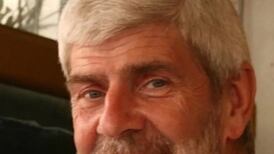The real Roberto Matta, the surrealist artist who has died aged 91, existed somewhere between the widely diverse judgments of two Americans, the critic Clement Greenberg, to whom Matta, cruelly, was "the prince of comic-strippers", and the poet and surrealist Patrick Waldberg, who wrote: "And finally, there was Matta ... whose equal surrealism was never to find again".
In 1941 and 1942, Matta tore away from gravity and plunged into the ether. To the large canvases that he painted during that period, one could apply the description that Victor Hugo gave of an unearthly spectacle: "The light had made all that shadow suddenly come to life, something like a mask that becomes a face. Everywhere gold, scarlet, avalanches of rubies, a rustling of flames. One would have said that dawn had suddenly set fire to this world of darkness."
"Between the idea and the reality/ Between the motion and the act," to borrow some lines from The Hollow Men, lay the underachievement of surrealism, a movement to which Matta was wedded from his acceptance, in 1938, by the keeper of the keys, André Breton, whom he met through Salvador Dalí.
He was always known only by those two syllables - Matta - but he was born in Chile as Roberto Sebastian Matta Echaurren, of French, Spanish and Basque blood. After training in Santiago as an architect, he left for Europe, travelling and studying paintings in the great galleries of Italy, Russia, Spain and England, where he met René Magritte.
In 1934, he arrived in Paris, and, until 1937, worked as a draughtsman in the office of Le Corbusier, where his originality and imagination were said, by his surrealist friends, to have startled his employer. He was a also phenomenal linguist and deeply intelligent, with a charm that opened doors everywhere.
On a trip to Cordoba in 1934, Matta stayed with the poet and dramatist Federico García Lorca. Before dinner one evening (in the telling of the historian of surrealism, Marcel Jean), one of the guests kept calling down from his room, "What shirt should I wear? The blue silk one or the white one?" "Put on the blue shirt," Lorca advised. "What about the trousers?" "Put on your black trousers." "And the jacket?" "Your embroidered jacket ... and don't forget your light-brown sombrero." When the guest came down, he was dressed, like the others, in a suit and white shirt - but everyone accepted he was in his imaginary embroidered jacket and sombrero.
Matta was intrigued. He obtained a letter of introduction to Dalí from Lorca. Encouraged by an English friend, Gordon Onslow-Ford, who had thrown up his family's plans for a career in the army to become a painter, he began to make his first drawings in 1937; by the time he left Le Corbusier's atelier, it was as an artist fully engaged in the notions of surrealism, and with the blessing of Dalí and Breton.
If only the surrealist painters had been able to encapsulate that kind of lightness of being. Surrealism had been around since Breton's first manifesto in 1924. Breton had accepted Sigmund Freud's view that dreams were "the royal road to the unconscious", and the aim of the surrealists was to overturn the tradition of reason and Cartesian rationality.
Breton's manifesto asserted "the omnipotence of the dream [and the\] disinterested play of thought", unhindered by convention: in other words, "pure psychic automatism" and Matta's apocalyptic explosions of light came closer to the surrealist ideal than any other, except those of Miró, the movement's one indisputably great painter.
At the outbreak of the second World War, an influential group of surrealists, including Matta, Max Ernst, André Masson, Wilfredo Lam and Yves Tanguy, found refuge in the US. Matta's first exhibitions in Manhattan were at the Galerie Julien Levy, but though his dynamic surrealism made an impact, his greatest influence was disseminated through his friendship with Robert Motherwell.
Matta felt that, through Motherwell and other American painters of his generation, surrealism could be revitalised.
Motherwell passed on the lessons of surrealism to William Baziotes, who introduced him to Willem de Kooning, Hans Hofmann, and Gorky, all of whom picked up the message of psychic automatism. Finally, he talked to Jackson Pollock, who listened and, Motherwell felt, swiftly calculated that Peggy Guggenheim, who ran the most avant garde gallery in New York, would approve of surrealism.
Matta called his paintings of the 1940s "psychological morphologies", a big but fairly accurate mouthful to describe his large abstract canvases, full of boulder shapes hurtling about in gaseous space - the kind of cosmic, but inward, landscapes that the painter likened to the vision gained by shutting eyes tight against the light. Indeed, he called these paintings "inscapes", a serendipitous link to the visionary English poet Gerard Manley Hopkins, who had coined the word to describe his own verse late in the previous century.
Matta continued at a high pitch throughout his life, though not always at the same level. In later years, he divided his time between Paris and a converted monastery in Italy.
He had been shaken by the revelation of the Nazi death camps, and later also produced anti-Vietnam war paintings, polemical works which he said were part of the class struggle.
His works of this sort are pallid but, mostly, he continued in the seam he had worked in the 1940s, and was still painting, drawing, designing for tapestry, sculpting, printmaking and etching in his last years. He is survived by his second wife Gemana Ferrari.
Roberto Sebastian Matta Echaurren: born November 11th, 1911; died November 23rd, 2002









